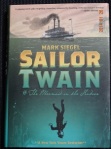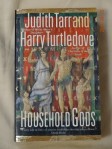 Title: The Last Roman
Title: The Last Roman
Author: Edward Crichton
Series: Praetorian Series ; book 1
Publication Information: c2012
Library of Congress Subject Headings:
Soldiers–United States–Fiction
Time travel–Fiction
Rome–History–Caligula, 37-41–Fiction
It’s the year 2021. The world in engaged in World War III. No nuclear weapons have been used yet, but it’s only a matter of time. Two billion people are already dead, and many cities lie in ruins. Pakistan and India are in all-out war. Russia is attempting to annex sections of Central and Eastern Europe–with the European Union at war with them. North Korea has overrun most of South Korea–a “rump” south still existing at the tip of the peninsula, where American forces are also fighting. As for Africa, “Their part in the conflict was, for once, not to fight amongst themselves, but to somehow put aside their differences and wage war against just about everyone else,” which thus destabilizes the entire Mediterranean Region. The Chinese, except for continued trade with the West, closes their borders and engages in war with the Russians. The South American countries are at war with each other. Even the United States’ neighbor, “… Mexico became a war zone when Mexico was overrun by guerilla [sic.] forces led by communists and warlords alike, who had been slowly building their armies for years, mostly thanks to Russian benefactors. Russia had finally succeeded where the Germans had failed during WWI by opening up a second front against The United States of America.” Most horrifyingly of all, the Vatican is attacked.
A terrorist attack (using gas) on the Vatican kills many pilgrims in St. Peter’s Square, but those inside the church are safe. (St. Peter’s facade is equipped with super-secret vents that can seal off the building.) “While millions of Catholics mourned, the attack had another unexpected side effect that would united all of Christendom in a way it had not seen since the days before Martin Luther. … No one had any idea that almost overnight, sects of Christians ranging from Anglicans, Baptists, and Lutherans to Protestants of all sorts, were in complete support of their Catholic brothers and sisters. The situation did not progress as far as uniting all Christians under a single religion, but there were many converts and the Pope began to influence decisions of all Christians again, not just Catholics.” (I guess the Bob Jones University crew and their like gave up their anti-papal rants for the greater good. And the Eastern Orthodox are never mentioned. Perhaps they aren’t considered Christians?) The Pope stops just short of calling for a new crusade. Still, a lot of people from various nations flock to serve him in a secret new wing of the Swiss Guards, an elite force secretly called the Pope’s Praetorians.
Jacob Hunter, the protagonist, is a former Navy SEAL who transferred because he wanted to “serve a greater good.” He’s Catholic, of course, but has had a troubled adolescence, stealing constantly. Somehow he becomes an excellent student who gets a BA in classics with a proficiency in Latin. His Masters degree is never completed, however, because his father insists that he go into the military; it’s a family tradition. In the end, Jacob becomes a SEAL. His mother dies while he is deployed, and ole’ Dad blames him for not being there. After the Vatican is attacked and Jacob transfers to the Praetorians, Dad is again unforgiving.
Once the group ends up in ancient Rome–pulled through a blue orb that can unbalance the mind the more time one spends around it–their leader already dead, the second-in-command, the priest in the group, assumes the leadership role, and he decides to help the Emperor Caligula in his conquests. Having brought along a huge amount of ammo from the future, the Praetorians begin their interference in history. Hunter warns them not to do it. (Hunter is also a science fiction geek.) He warns that tampering with history can have dire consequences.
Nonetheless, the priest leads his team to completely support Caligula in any way they can. Except that the priest isn’t what he appears to be. See, papal intelligence knows about the orb being a time machine of sorts, so the “priest,” who has never taken holy orders, is sent back to change time so that (I assume) World War III will not take place. This is justified because Jesus had already been crucified, and the Church had already been established. (Nothing “relevant” would be changed?)
I don’t even know where to start. I couldn’t even get my mind around the premise. That’s the problem with these future end-of-the-world stories for me: they have to have some plausibility with what’s actually going on in the world. Most of them don’t. All the states in Africa turning their attention outward to make war is incomprehensible. If Russia and China were fighting along their huge border, I doubt that the Russians would be able to continue attacking the EU or support the American “second front,” Mexico. North Korea could expect little help from an embattled China if it invaded South Korea. And, of course, the shrinking U.S. military budget is also to blame for much of America’s woes.
All Christian sects, excepting the Catholics and Uniates, agree on one thing: the Pope is not the supreme head of the church. A bomb leveling St. Peter’s Basilica wouldn’t bring the churches back together under the leadership of the Pope. The Crusades were a military failure; they did nothing to stem the tide of Muslim expansion. The Fourth Crusade gravely weakened the Byzantine Empire–a Christian state that had held off the tide of Islam from engulfing Europe in the Dark Ages. Gravely weakened, the Byzantines could not stop the advancing Turks, and the empire ended with the fall of Constantinople in 1453. That crusade also diverted much needed aid from reaching the Holy Land, which only hastened the fall of the Crusader states along the coast. The medieval papacy was militaristic, basically abandoning spiritual matters, which led to corruption, which eventually led to the Reformation.
Almost the first quarter of the book is spent on weaponry and what it can do, what ammo it takes, etc.; it became techno-babble to me. Hunter’s got a repeating rifle that can shoot so many yards with exploding ammo. Okay, that’s all I need. I nearly gave up reading the book when the group was pulled into the Rome at the time of Caligula, so I decided to stick it out.
Romans did not wear togas all the time. People are digging in togas, Praetorians are wearing togas over their armor, there’s togas everywhere. When Hunter first sees the men in togas, he says that they resembled fraternity guys at a keg party. Togas look nothing like frat boys wrapped in bedsheets. Togas were an extremely complex dress that was hard to wear. The person needed help getting the garment on, getting it adjusted, and then had to carefully help hold the toga together. It was a pain in the ass to wear and only worn on formal occasions.
Oh, and Caligula could never have crucified a fourth of the Senate or any other citizens, since Roman citizens could not be crucified. It was against Roman law to crucify any citizen. Crucifixion was reserved for non-citizens and slaves. This is why Jesus of Nazareth, a non-citizen, and the followers of Spartacus, all slaves, could be crucified. St. Paul, who was a Roman citizen, was beheaded.
I read some of Jerry Ahern’s The Survivalist pulp novels when they first came out. Those books dealt with post-World War III, but there was no time travel involved. The old Soviets-vs.-America war was once more rehashed, and I quickly got tired of it and gave up after the third novel. This novel reminded me of them.
Obviously, this book wasn’t my cup of tea. If you like military hardware and love having military protagonists blazing through adventure after adventure, then this one is for you.









